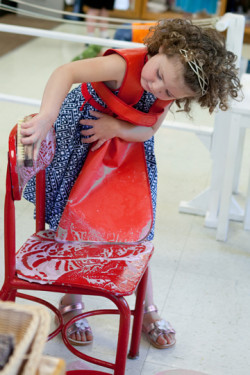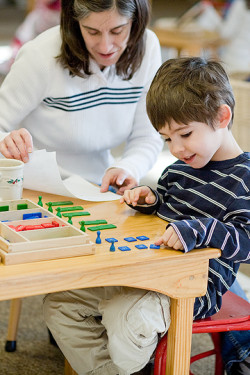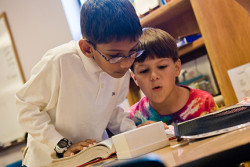Madison Community Montessori School offers authentic and engaging Montessori programs starting at 15 months of age and lasting into adolescence. As an AMI/USA member school, MCMS offers an education that is an aid to life where your child’s passion and creativity is funneled into meaningful work appropriate for their developmental stage. Children progress through MCMS’s programs learning to value experimentation, exhibit grace and courtesy, care for their environment and the natural world, and maintain a love of learning. Our Portrait of a Graduate demonstrates the ways in which an investment in Montessori education at MCMS produces students mature in both their intellect and their humanity.
Children from 15-36 months are together in the MCMS Toddler Community, and generally progress to Children’s House around age 2 1/2 and when they are able to use the toilet with little help. Children stay in Children’s House for three to four years, from around age 3 through age 6. The last year of Children’s House is equivalent to the Kindergarten experience in a conventional school setting.
A child age 6-12 is in their second developmental plane, and begins in Lower Elementary with other students ages 6-9 (first through third grade). Students in Upper Elementary are generally 9-12 years old (fourth through sixth grade).
Once a child reaches age 12, they enter the third plane of development and are ready for the Adolescent Program at MCMS. This is the grade-level equivalent of a conventional seventh and eighth grade middle school setting.
At each level, the benefits of the Montessori Method of education are in full view at MCMS, as explained below.
The Prepared Classroom Environment at MCMS

Montessori classrooms serve as a prepared environment where children are free to respond to their natural tendency to work. Children view their lessons as important work in the same way that the adults in their world do. The children’s innate passion for learning is encouraged by opportunities to engage in spontaneous, purposeful activities with the guidance of a trained adult, the Montessori teacher. Through their work, children develop concentration and joyful self-discipline. The environment is carefully designed to allow them to progress at their own pace and rhythm, according to their individual capabilities, within a framework of order.
The prepared environment contains all of the essential elements for optimal learning and development, specifically designed for each successive developmental plane of the child (15-36 months, 3-6 years, 6-9 years, 9-12 years, 12-14 years). At MCMS, every classroom has direct access to the outdoor environment allowing children to easily explore lessons in botany and zoology.
Characteristics of the prepared environment, some of which are explained further below the video, include:
- A trained Montessori teacher observing children at work and guiding them toward mastery of their efforts.
- Beauty, order, reality, simplicity and accessibility in the classroom.
- Freedom of movement to work within suitable guidelines that enable children to act as part of a social group.
- Specifically designed materials that help students explore their world and develop essential cognitive skills.
- Multi-age classrooms that encourage children to develop their personalities socially and intellectually at their own pace.
- Class sizes large enough (typically between 27-32 children per class) to ensure healthy social development.
- A 3-hour work period available for children to choose work that interests them and develop their self-direction.
Compare the Montessori method to traditional education here, or learn more by watching this video:
The Role of the Montessori Teacher

A Montessori teacher is an observer whose ultimate goal is to intervene less and less as the child develops. The teacher creates an atmosphere of calm, order, and joy in the classroom and is there to help and encourage the children in all their efforts, allowing them to develop self-confidence and inner discipline. The teacher demonstrates the use of materials and presents activities based on an assessment of the child’s requirements. Knowing how to observe constructively and when and how much to intervene is one of the most important talents the Montessori teacher acquires during her rigorous Montessori training. At MCMS, Montessori teachers are often referred to as “Guides”, charged with the enormous responsibility of guiding each child along his individual path of learning.
Montessori Materials
In her early work, Dr. Maria Montessori observed that the younger children were intensely attracted to sensory development materials. Children used these materials spontaneously, independently, repeatedly and with deep concentration. They emerged from this spontaneous activity renewed and with a profound sense of inner satisfaction – not because an adult instructed them to manipulate the materials, but because they were allowed the freedom to experience the materials as they were ready. From this initial discovery, and over many years of observation, Dr. Montessori designed an entire range of Montessori materials, available in each classroom at MCMS.
A child’s teacher observes each child’s readiness and presents the appropriate Montessori materials to a child at the appropriate time in their development. This allows the child to engage in self-directed, purposeful activity. The materials are beautiful and enticing and are displayed in an orderly and accessible way.
Multi-Age Classrooms
One of the hallmarks of the Montessori Method is that children of different ages work together in the same classroom, grouped together based on Dr. Montessori’s observations about planes of childhood development. Because the work is individual, children progress at their own pace with an emphasis on cooperation rather than competition between the ages.

Students remain in the same classroom at MCMS for the full two or three year experience, moving from the youngest to the oldest in the classroom community. Older students serve as teachers and leaders, showing younger children how to do things. This reinforces their own learning and naturally boosts their self-esteem. Younger peers are often motivated to learn by observing their older peers and seeing the next steps in a series of lessons. Multi-age classrooms allow students to progress at their own pace without the stigma of grade levels and take on new challenges as they are ready without having to wait for the next school year to begin.
The Montessori Method at MCMS
The Montessori Method encompasses far more than only traditional academics. It is designed to help children with the enormous task of developing as a human being as they grow from childhood to maturity. At MCMS, the Montessori approach succeeds because it draws its principles from the natural development of the child, which the teachers monitor through careful observation. Its flexibility allows each individual child’s inner directives to freely guide him toward wholesome growth. In the end, the child not only knows his academics, but he also knows and understands who he is, how he fits into the greater community and how he can best contribute to the world around him.
